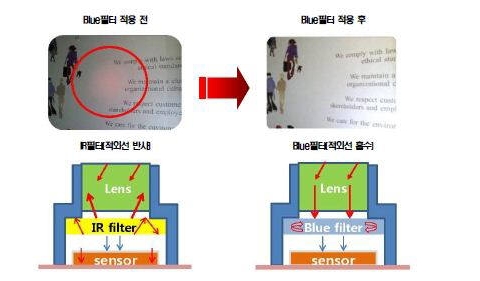Korean materials makers are successively starting localization of blue filters used in high-resolution smartphone cameras. This is because, as the pixel count for camera modules used in smartphones and tablet PCs exceeded 8 million and 13 million respectively, the demand for blue filters is increasing gradually. In the New Year, Korean companies’ influence in the blue filter market is expected to be even more prominent.
According to the industry on the 30th, OPTRONTEC positioned itself as a leader in the blue filter market and, following OPTRONTECH, late comers into the market, such as Nanos and LMS, started technology localization.
Blue filter came into the limelight according to the advancement of camera modules for application in smartphones. In camera modules of 8 million pixels or higher, a back-side illuminated (BSI) image sensor is used instead of the front-side illuminated type in order to increase the amount of light. BSI image sensor takes in a large amount of light. However, it is subject to an optical distortion to bring up bluish tint in photos. Blue filter is used to solve this problem.
Up until 2011, the global blue filter market had been dominated by foreign companies including Asahi Glass. OPTRONTEC succeeded in localizing blue filter production with glass from Schott of Germany. Although the product performance is slightly weaker than that of Asahi Glass, OPTRONTEC soon positioned itself as a leader in the blue filter market based on its high price competitiveness. The company’s blue filter sales increased from only 1% of net sales in the beginning of last year to as much as 50% at the moment. Blue filter is sold at prices higher by three ? five times than the existing infrared filters, and thus contributes significantly to increasing the company’s profitability.
Nanos has set out a goal to localize all technologies ranging from substrate glass to blue filter. It has been promoting glass localization for several years with government’s funding support and the efforts are producing effects this year. Nanos is strengthening marketing for 13 million and 16 million pixel camera module markets.
LMS succeeded in developing a blue filter in the method of coating general soda lime glass sheets. This company benefited from using its technological power secured through LCD prism sheet manufacturing in blue filter development. LMS is supplying blue filters mainly to camera module makers in China.
“Korean blue filter is outstanding in quality and performance and has high price competitiveness. Therefore, it will sufficiently make its way in the global market,” said an industry insider. “We forecast that the number of companies promoting material localization targeting niche markets will increase.”
Blue filter market is forecast to grow in proportion to the expansion of BSI image sensor market. Chinese smartphone makers have been using Chinese blue filters of inferior quality or not using it at all. However, as the performance of Chinese smartphone cameras is improving recently, these companies are trying to secure the supply of Korean blue filters.
It is forecast that the tablet PC market growth will also accelerate the increase of blue filter demand. In the New Year, the global tablet PC market is expected to grow by approx. 45% from this year. In particular, Samsung Electronics, according to sources, will double its tablet PC forwarding volume next year.
Lee Hyeong-soo | goldlion2@etnews.com
고화소 스마트폰 카메라용 블루필터 시장 급성장...국내 업체 소재 국산화 잇따라
국내 소재 업체들이 고화소 스마트폰 카메라에 쓰이는 블루필터 국산화에 잇따라 뛰어들고 있다. 스마트폰?태블릿PC의 카메라모듈이 800만?1300만 화소로 넘어가면서 블루필터 수요도 꾸준히 늘고 있기 때문이다. 새해 블루필터 시장에서 국내 업체들의 영향력은 더욱 두드러질 것으로 기대된다.
30일 업계에 따르면 옵트론텍이 블루필터 시장에서 주요 업체로 자리잡은데 이어 나노스?엘엠에스 등 후발 기업들도 잇따라 기술 국산화에 나섰다.
블루필터는 스마트폰용 카메라모듈이 고도화되면서 각광받게 된 소재다. 800만 화소 이상 카메라모듈에는 광량을 높이기 위해 전면조사형(FSI) 이미지센서 대신 후면조사형(BSI)이 쓰인다. BSI 이미지센서는 많은 빛을 받아들이지만, 사진에 푸른 빛깔이 생기는 광학적 왜곡이 발생한다. 이를 해결하기 위해 블루필터가 쓰인다.
지난 2011년까지만 해도 블루필터 시장은 아사히글라스 등 해외 업체들이 선점하고 있었다. 옵트론텍은 독일 쇼트로부터 유리를 공급받아 블루필터를 국산화하는데 성공했다. 아사히글라스보다 성능은 조금 떨어지지만 가격 경쟁력이 뛰어나 블루필터 시장에서 단번에 선두 업체로 자리잡았다. 지난해 초 1% 수준에 불과했던 블루필터 매출 비중은 현재 50% 수준으로 늘었다. 블루필터는 종전 적외선 차단 필터보다 3~5배 높은 가격에 판매돼 회사 수익성에도 큰 도움이 되고 있다.
나노스는 원판 유리부터 블루필터까지 모든 기술을 국산화한다는 목표다. 몇 년 전부터 정부 자금을 지원받아 유리 국산화를 추진해왔는데, 올 들어 효과를 보고 있다. 이 회사는 1300만?1600만 화소 카메라모듈 시장을 타깃으로 영업을 강화하고 있다.
엘엠에스는 일반 소다라임 유리에 코팅하는 방식으로 블루필터를 만드는데 성공했다. LCD 프리즘시트를 제조하면서 확보한 기술력을 블루필터 개발에 활용해 효과를 톡톡히 봤다. 최근 중국 카메라모듈 업체에 주로 공급하고 있다.
업계 관계자는 “한국산 블루필터는 품질 성능이 뛰어나고, 가격 경쟁력도 높아 세계 시장에서 충분히 통할 수 있다”며 “틈새 시장을 타깃으로 소재 국산화를 추진하는 업체들이 점차 늘어날 것”이라고 말했다.
BSI 이미지센서 시장이 확산되는 것과 비례해 블루필터 시장은 성장할 것으로 보인다. 특히 중국 스마트폰 업체들은 그동안 블루필터를 아예 쓰지 않거나 품질 수준이 떨어지는 중국산 제품을 주로 썼다. 그러나 최근 중국 스마트폰용 카메라 성능이 급격히 높아지면서 한국산 블루필터 찾고 있다.
태블릿PC 시장 성장도 블루필터 수요를 부채질할 것으로 보인다. 새해 세계 태블릿PC 시장은 올해보다 45% 가량 성장할 것으로 예상된다. 특히 삼성전자는 올해보다 두 배 가량 태블릿PC 출하량을 늘릴 것으로 알려졌다.
이형수기자 | goldlion2@etnews.com
